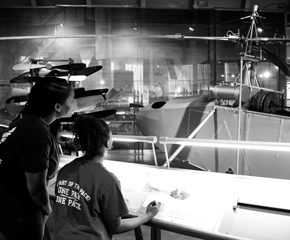Reducing Waste at THF: Recycling and Composting
The road to diverting waste from landfills is naturally a long one. The process involves more than simply owning a receptacle for recyclables. In Michigan, recycling has waned significantly in recent years, which is why The Henry Ford must be a leading example of the potential impact we have on our environment by reducing and diverting waste.
Single-Stream Recycling
The Henry Ford's strategic goal to "cultivate environmental responsibility" includes tracking our waste streams, educating the wider public about its importance through informational signage, and diverting them to a home where they can be reused instead of wasting away in a landfill.

Receptacles for recycling and landfill waste at Stand 44 restaurant / Photo courtesy of Aias Danier
Tracking recycling (cardboard, plastic, paper, and metal) and landfill (all other waste) usage across the entire campus of The Henry Ford, including facility offices, and educating the public require considerable thought from both an operations and aesthetics perspective. Educating the public (and staff) requires a powerful and effective front-end presentation paired with an equally efficient back-of-house operation. To further this effort, multiple departments are cooperating to improve our front-end museum recycling experience while upgrading our back-of-house programs and recycling areas to accommodate. Operationally modern recycling bins with a historical touch, carefully considered front-end signage, a cleaner back-of-house program for efficient hauling, and optimized roll-off dumpsters for more accurate waste tracking are all significant steps on the road to Zero Waste.
Specialized-Stream Recycling
Our recycling endeavors extend beyond simply evolving our recycling participation within the museum and facility offices. We seek to engage in specialized waste reduction recycling streams that cannot be mixed in with our single stream-hauler. A few of the significant catagories that are being considered by The Henry Ford include:
Glass: Glass is a heavy material of comparatively low value that often requires specialized equipment to recycle. Depending on your location, your single-stream waste hauler may or may not be capable of handling it. However, with the amount of wine and liquor bottles that our Catering Department handles for events, there is plenty of demand and material to justify a special waste stream for hauling. And thankfully, there are a few companies in our area that are capable of recycling it. Once picked up, these bottles can be hauled to a facility where they are crushed into fine particles and can be used for a variety of projects such as insulation, décor, or as material to make new bottles or aggregates.
Batteries: Battery recycling is on the rise thanks to the reuse potential of its raw materials. In fact, when ground down and separated from its packaging and casing, the resulting material is a rich black, almost soil-like color that is colloquially referred to as “black gold.” However, batteries in single-stream recycling and landfills can be dangerous exactly because those raw materials can leach out of the casing onto recyclable materials or even cause a fire to break out in a landfill.
Batteries, just like glass, often require specialized equipment to be recycled effectively and safely.

Battery recycling container / Photo courtesy of Aias Danier
Various Plastic Packaging and Sheeting: LDPE (low-density polyethylene or more recognizably "Number 4 Plastic" like wrap and films), and polystyrene (more recognizably "Number 6 Plastic" like packaging foams and food containers) are often not recycled due to the economic impracticality, but a few businesses across the United States have been able to find new uses for recycled plastic sheeting.
The most common acceptable way to recycle plastic sheeting is through retail stores that participate in plastic collection programs.
Retail stores often participate in these bag recycling programs where customers can drop off their plastic waste and have it hauled to a partnering plastic bag recycling facility or company.
For example, there are companies that make composite decking from a mixture of sawdust and recycled plastic films. Partnerships with companies like these could elevate recycling initiatives closer toward Zero Waste.

Plastic sheeting that requires specialty recycling / Photo courtesy of Aias Danier
Paper: Paper is a generally accepted material to recycle, though can sometimes be complicated to dispose of if the contents are proprietary.
We at the The Henry Ford have a higher demand to dispose of sensitive business documents in a secure fashion due to our administration structure. It is typically more efficient to have a specialized paper shredder company to come on-site with a special box truck to shred our sensitive documents directly on campus before hauling it off to be recycled normally.
Investing in our own paper shredder or numerous smaller paper shredders for a more secure and cost-effective method of handling all paper waste may be of interest to the The Henry Ford in the future, especially if cardboard can be included in that stream.

A collection of paper ready for the shredder / Photo courtesy of Aias Danier
The Facilities team at The Henry Ford remains committed to navigating waste streams, now and into the future. Sharing this work expands our efforts to cultivate environmental responsibility.
Aias Danier is assistant construction manager at The Henry Ford

